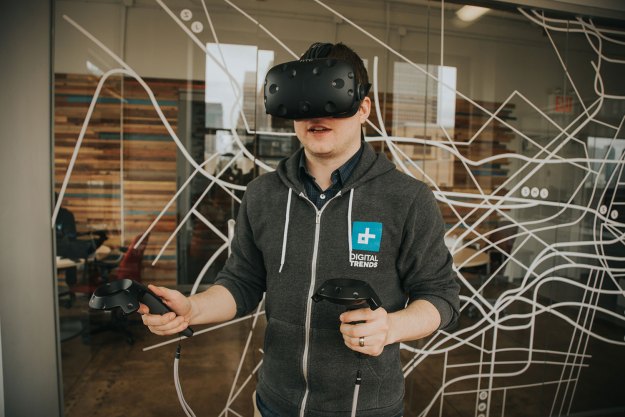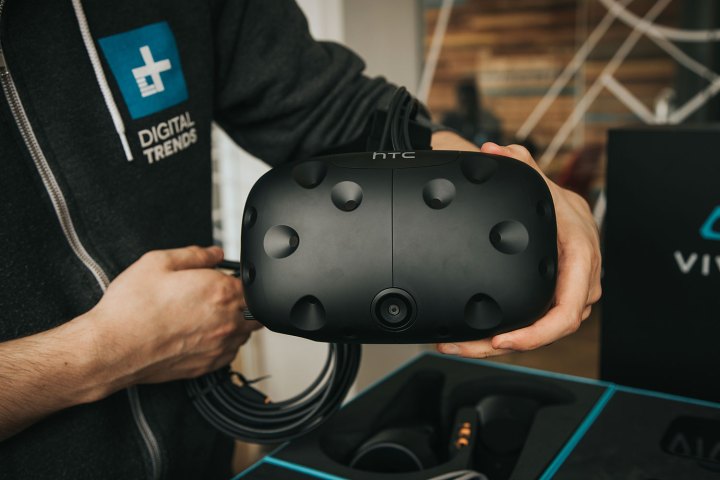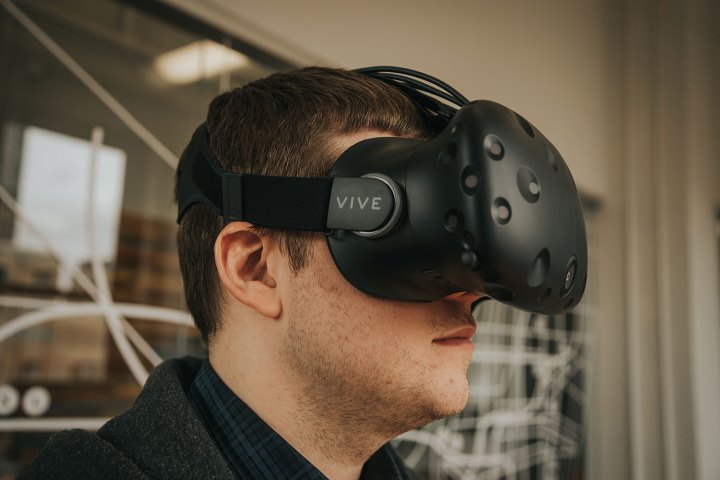
- Incredibly immersive
- Hardware works well
- Decent launch library
- Precise, intuitive controls
- Easy to set up
- Headset cord can get in the way
- Field of view isn’t wide enough for full immersion
- Headset can get sweaty
There are only two serious companies in the PC-based VR world. Facebook’s Oculus and HTC’s Vive.
The Oculus Rift VR headset came first, but it was largely designed for seated or stationary use. That means it’s at its best only in certain specific genres, such as cockpit games. The HTC Vive, its primary competitor, is meant to be used in a room while standing or walking (though it can also be used sitting). Upon the Vive’s release, that was a design decision that instantly made it feel more immersive, creating a Star Trek holodeck-like space in your room to virtually walk around in.
The HTC Vive has been reduced down to $500 on its own, although of course you’ll want a system that’s capable of handling its requirements. The question now is as follows: At its new value price, can it compete with newer headsets like higher-resolution, $800 Vive Pro or the stand-alone Oculus Go?
Sturdy, sleek
The Vive looks like a device pulled straight out of the future. The infrared tracking dots that appear across the face of the headset are indented from the rounded shape of the headset, creating a distinct look and one that’s more aggressive than the Oculus Rift and other VR headsets, which are more elegant and streamlined. Personally, we find the Vive attractive, at least in the sense that it looks as futuristic as virtual reality feels.
It helps that every piece of the kit, from the trackers, to the controllers, to the cables and the link box, is built from sturdy, thick plastic. It does mean the headset itself is pretty heavy, but as we’ll see, balancing weight properly is more important than shedding pounds.
The controllers are unique. While the closest resemblance might be to a Nintendo Wii Remote, even that feels forced. Their interesting shape is often replicated visually in-game, and the odd ring at the top becomes the perfect place to house gems, or grab objects.
Unfortunately, serious construction and solid connectivity comes at a price, and that price is the Vive’s cable. It’s thick and can be a little unwieldy, especially in games with a lot of spinning or moving around. You’ll get used to it after a while, but it isn’t the most elegant solution. We’re always a little afraid of tripping over your cord.
The cables run into a link box instead of straight into the computer. That makes it easy to run all the cables for power, USB, and HDMI to the same place, without needing a separate power cable. It also acts as a breakaway in case you get a little too enthusiastic, preventing you from yanking an expensive gaming PC off its desk.
Comfort comes first
The Vive’s headband has improved drastically from the Vive Pre’s attachment mechanism. The bands on both the sides and top are much sturdier and thicker. The Velcro has side tabs to help adjust the fit while the headset is on, and most people find a comfortable fit in less than a minute.
This is the VR experience you’ve always dreamed of.
It helps that the face gasket on the headset itself is quite squishy and goes all the way around your eyes, with a short break at the bottom for the rubber nose rest. Once it’s fit correctly, there’s no pressure points around the outside of the headset — which thankfully means no “VR face,” an issue with some headsets that leaves a red ring around your eyes.
That hasn’t stopped us from sweating into the Vive on a number of occasions. Especially in games like Hover Junkers, which involve a lot of jumping around and ducking, the foam frame turns into a bit of a sweatband. It’s not dripping, but it’s enough to make you think twice about handing over the headset to someone else after an intense session.
Virtual reality that won’t make you hurl
We invited a handful of Digital Trends employees to test out the Vive for brief demos, to identify any nausea-inducing problems with the headset. Reactions were so positive that we had to drag people screaming out of the virtual world. From The Lab to Hover Junkers, all our test subjects wanted to do was play more, check out the other games, and come back around for seconds. Only a couple of our testers reported headset-related comfort issues, which were mostly solved with headband tweaking.
All testers reported high levels of immersion, and a common high note was the precise, intuitive nature of the controls. Nausea was missing in action, even among individuals normally prone to motion sickness. Letting the user Vive move in real space while also moving in virtual space, as the Vive allows, seems to dramatically improve long-term comfort relative to a seated headset.
A few games available on SteamVR, like 4089: The Ghost Within did give us nausea. This game, and others that only work with a standard Xbox controller, exhibit many of the limitations of the Oculus Rift (and its dev kit predecessors). You have to sit down while playing, and the head tracking is slow.
The biggest problem with the Vive might be how much activity it does require. A few of our testers reported that using the headset was “a lot of work,” in the sense that moving around to play a game is a lot less relaxing than plopping down on a couch. The Vive, though immersive, may not be the device you’ll turn to after a long, tiresome day at work.
There are also some accessories you could invest in that use HTC’s Vive Tracker hardware, but we spent some time with them and you’re probably better off sticking with the included touch-controllers.
A beautiful display from a narrow perspective
Before we get too technical about the details of the Vive’s display, we have to note that every head-mounted display (HMD) we’ve tried to this point has had some amount of what’s referred to as the “screen door effect.” No matter how high resolution screens get — and that’s not to discount the 2,880 x 1,600 total resolution of the Vive Pro — it’s not too tough to see the individual pixels when it’s just an inch or two from your eyes.
The upshot is that as long as the processing, UI, and tracking are sharp enough, the screen door isn’t too distracting. I’ve also found that after a few minutes of playing a game, the immersion is enough to stop your eyes from looking for it. It also helps when games adapt their aesthetic to this sort of effect. Resolution issues are most clearly visible on distinct edges, especially on cartoon characters. Higher definition textures, landscapes, and flat surfaces especially look quite a bit sharper.
Our main complaint about the Vive’s display is not the screen door effect itself, but rather the edges of the display, and the rings around the field of view. When the edges of your vision are dark, the supporting structure blends in. When the screen is brightly lit, it’s like wearing a pair of sunglasses with big, dark frames. It’s not detrimental to the experience, but in quiet moments it can definitely downgrade the sense of immersion.
The Vive includes a pair of basic earbuds, although we have a feeling most of you will prefer your own headphones. Even over-ear headphones fit comfortably with the headset on, and there’s a 3.5mm plug on the back so your headphone cable doesn’t have to reach from the link box.
The virtual reality you’ve always dreamed of
All of these elements don’t mean much if they don’t come together to form a cohesive, engaging experience. Thankfully, they do. Being able to move around, even in a small space, is a huge boon to realism. Even after several hours of play, we found ourselves reaching out to touch a fish swimming past in TheBlu, or ducking quickly behind cover in Hover Junkers.
That freedom of movement also helps keep the virtual world engaging when you might not want to be a part of it. Survival horror games force you to face your fears, even as you cower in the corner of the usable space. When a humongous jellyfish floats toward you, you can’t help but step out of its way.
Add in online play, and things only grow more enthralling. Hover Junkers places you as the driver and defender of your own hovercraft in a deserted wasteland. Hiding behind junk you dug out of the ground while firing off shots at a real opponent is immediately gratifying, even more so when you show them a rude gesture as their ship explodes into pieces.
Part of the draw with the HTC Vive is, of course, the Steam marketplace. Not only are there a wealth of games ready to play, or coming soon, that support room-scale virtual reality, but veteran PC gamers may already have games in their library that support the headset.
Surprisingly robust software
The Rift is no slouch when it comes to ease-of-use and the overall user experience. Indeed, that was a primary focus of Oculus as it developed its headset. But the Vive is no slouch, either, which is a bit surprising given that it’s a joint expedition by two companies, rather than a product built under a single umbrella.
The headset and controllers are built from sturdy plastic that’s pleasing to touch.
Setting up the device means following a process outlined by Valve. While there’s no shortage of cords to connect, and positioning the lighthouse sensors that detect your position in the room can be a pain (they must be at least 4-5 feet high, or higher, and ideally tilted slightly towards the ground), the technical understanding requires is minimal. There’s just a few buttons to press, and connectivity issues were rare, despite the fact both the lighthouses and the controllers communication wirelessly.
You can launch into VR either through the Steam desktop software by starting a VR-compatible game, or by launching SteamVR, which opens a front end that’s very similar to Steam’s Big Picture mode. It’s not as attractive as Oculus’ comparable home screen, but it operates similarly, and we found it reasonably intuitive.
The Vive is not a plug-and-play device. Some level of understanding is required. But if you’ve ever hooked up and mapped a PC joystick, connected a wireless printer, or installed a piece of PC hardware, you should find the Vive’s setup a cinch.
Our take
You’ll need three things to experience what the Vive has to offer: A VR-ready computer with a very nice graphics card, enough space for room-scale experiences, and $500. The first two aren’t as much of an issue as they seem on the surface. The hardware required for Vive compatibility is already lower than that of a Rift-ready PC, and Valve’s specifications are just suggestions for optimal performance. If you’ve got everything you need, the HTC Vive is the best way to transform your space into a portal to virtual reality experiences.
Is there a better alternative?
Not yet. The Vive Pro is certainly a better headset, but we didn’t find that the experience justified its significantly higher cost.
For now, the HTC Vive and Oculus Rift are pretty evenly matched. We like the Vive better, but the Oculus Rift does come in at just $400, which leaves you some extra money for PC upgrades or new games. It’s an appealing alternative that is almost as good as the HTC Vive, even if it isn’t quite as capable at room-scale experiences.
How long will it last?
Physically, the HTC Vive is a robust headset, the one here in the office has survived ever since launch without so much as a scuff or a broken cable. It might not wear out any time soon, but it will start showing its age pretty quickly as new headsets hit the market.
HTC includes a one year limited warranty. That’s the standard offering, even for high-end gaming peripherals. The Oculus Rift also offers a one-year warranty.
Should you buy it?
Yes. Even if you’re not into VR, or have no interest, you at least need to try the Vive. This is the VR experience you’ve always dreamed of. It’s the closest thing we’ll get to The Matrix anytime soon.










